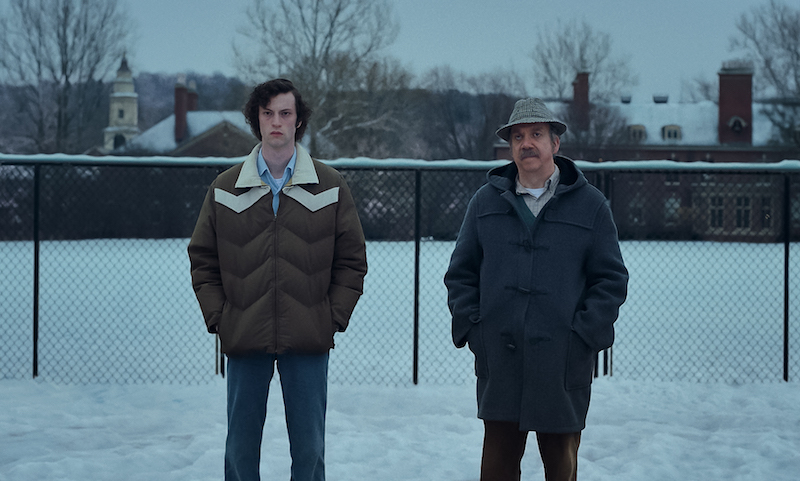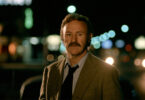When Alexander Payne releases a movie, it’s an event.
Why? Because he tends to make great films. Among his best: “The Descendants” (my favorite movie of the 2010s), “Sideways,” “Nebraska” and “Election.” His humor can be uproariously twisted, and yet Payne usually depicts his characters with empathy, and life as poignant, bittersweet – worth living despite the pain.
“The Holdovers” (R, 133 minutes, in theaters) reunites the director with his brilliant “Sideways” star Paul Giamatti, and they’ve come up with another winner.
Giamatti plays Paul Hunham, a rigid, embittered teacher of classics at an exclusive boarding school for boys in New England. It’s Christmas vacation, 1970, and because he’s been a thorn in the headmaster’s side (he won’t give a donor’s kid a passing grade), Hunham is required to babysit five students who have nowhere to go during the break.

Dominic Sessa stars as Angus Tully and Paul Giamatti as Paul Hunham in director Alexander Payne’s THE HOLDOVERS, a Focus Features release.
Credit: Courtesy of FOCUS FEATURES / © 2023 FOCUS FEATURES LLC
Though he wouldn’t be doing anything else – he has no family – Hunham is still exasperated by this turn of events. He views his students as spoiled, ungrateful brats, most of whom will be lucky just to pass his class. When one of his students, upon getting a poor grade on a test, whines that he just can’t fail the class, Hunham corrects him: Oh, he definitely can.
Sure enough, the start of the winter vacation is miserable for all concerned, with the stern teacher clashing with his rebellious students. Eventually, circumstances change, with Hunham, student Angus Tully (Dominic Sessa, who looks like a young Ben Affleck), and Mary Lamb (Da’Vine Joy Randolph), who runs the academy’s cafeteria and is mourning the death of her son Vietnam, growing closer.
The general direction of the plot is predictable; the appeal here is in the dialogue (especially Giamatti’s: “Listen, you hormonal barbarian…,” “I find the world a bitter and complicated place – and it seems to feel the same way about me”), the character development, the acting (especially Giamatti’s and Randoph’s, both likely to result in an Oscar nomination).
Another plus: the settings. The film was shot in and around Boston, and you really get a strong sense of the Northeast in general, and the city in particular, in the winter. There’s a scene that was shot in the Somerville Theater, which is where I saw the movie (Payne appeared for a Q-and-A afterward). So there I was – watching a scene of characters watching a movie (“LIttle Big Man”) in the theater where I was watching “The Holdovers.” Weird … in a good way. ***½
Life as a killer
What does it take to be a paid assassin?
Director David Fincher (‘Fight Club,” “Zodiac,” “The Social Network”) explores the qualifications in the cerebral neo-noir “The Killer” (R, 118 minutes, on Netflix).
Michael Fassbender plays an unnamed high-end hit man – the Killer – who provides an internal monologue throughout the film that deals with his views on life, morality, his occupation and himself.
“Popeye the Sailor said it best,” he says early on. “‘I am what I am.’”
He doesn’t believe in luck, karma or justice, he says. He’s very careful, very logical, as he goes about his work, which often can be boring and requires great preparation. “Anticipate, don’t improvise,” he says.
And there’s no room for sentiment or sympathy. “I’m not here to take sides,” he says, noting the secret to his success: “I don’t give a fuck.”
The Killer runs into trouble, though, when he messes up an assignment in Paris. Suddenly, he finds himself the target, and he must use the same cold-blooded professional approach to defend himself. This mission in self-preservation takes him to the Dominican Republic, New Orleans, Florida, New York and Chicago while tracking down – along with a cabbie named Leo (Gabriel Polanco) – the Lawyer (Charles Parnell), the Brute (Sala Baker), the Expert (Tilda Swinton), the Client (Arliss Howard). His various encounters with these diverse characters give “The Killer” an episodic feel which works in the film’s favor.
Swinton stands out as a sophisticated killer, described as looking “like a Q-tip,” who knocks down a flight of whiskeys and discusses their chosen profession as the Killer stares at her from across the table at a posh restaurant. Kerry O’Malley, as the Lawyer’s assistant, also is memorable as someone desperately hoping for a reprieve from the Killer’s modus operandi.
Fassbender’s Killer tries to be a nonentity, in a sense. But Fincher and screenwriter Andrew Kevin Walker (who also collaborated with the director on “Se7en”), adapting a French graphic novel, give the central character certain amusing personality quirks. He always listens to the Smiths, for instance, and he uses the names of old TV sitcom characters – Lou Grant, Sam Malone, Archibald Bunker, George Jefferson, etc. – as his aliases. He’s obsessed with statistics, and he loves to eat junk food from McDonald’s. He’s a fun guy, unless he’s about to liquidate you. ***½ (out of four)
Director gives Brian Jones his due
Brian Jones might be the most fascinating of the Rolling Stones. Yep, maybe even more fascinating than Keith Richards. But, having drowned in 1969 at 27 (thus becoming an early member of the 27 Club of celebrities dying at that age), Jones is not as well-known as surviving Stones Mick Jagger and Richards, or probably even the late drummer Charlie Watts or former bassist Bill Wyman, at least among younger fans.

1964: Rock and roll band “The Rolling Stones” pose for a portrait. (L-R) Bill Wyman, Keith Richards, Mick Jagger, Charlie Watts, Brian Jones. (Photo by Michael Ochs Archives/Getty Images)
Documentary filmmaker Nick Broomfield attempts to remedy this lack of recognition with “The Stones and Brian Jones” (93 minutes, in theaters and streaming). Broomfield, whose previous subjects have ranged from Kurt Cobain and Courtney Love to serial killer Aileen Wuornos and “Hollywood Madam” Heidi Fleiss, reveals how Jones was the group’s founder and leader, and how his love of the blues and his musical versatility and skill in many ways defined the Stones’ direction – at least in the beginning.
Then Jagger and Richards started writing rock songs that gradually overshadowed the blues covers, and Jones, who did not write, found himself more and more in the background. His heavy drug and alcohol use, poor health and clashes with band members eventually led to his ouster, his drowning coming soon afterward.
While detailing all of this, Broomfield provides a behind-the-scenes portrait of a complex young man: rebellious, but always looking for affirmation from his parents; described as cruel or kind (depending on who is talking); a “gentleman” known to move into the family homes of his girlfriends, impregnate the girlfriends, then disappear; a passionate musician who became unreliable because of his excesses.
Broomfield uses many interviews from past and present featuring Jones and the rest of the Stones (his best pal in the Stones, Wyman, appears in new footage), Paul McCartney, Marianne Faithfull, Eric Burdon, and various lovers, among others.
Broomfield, a London-born fan of the Stones since the ’60s, also speaks, but he’s more restrained, much more in the background here than in his previous films – and that’s a shame. Broomfield often appears in his films as a kind of investigative journalist, who becomes central to the story as we join him in his journey to get to the bottom of the secret lives of his subjects. Sometimes he seems like a sensationalist tabloid reporter; other times he seems sincere. He’s usually as interesting (often in a humorous way) as the people he profiles.
Yet, here, not only does he mostly keep his distance, he avoids possibly the most provocative detail of Jones’ life: the circumstances surrounding his death.
Was it murder? Books and other sources have claimed that Jones didn’t drown in his pool accidentally, but was killed. Police reviewed the case decades later, but decided not to conduct another investigation. Nevertheless, it’s strange that Broomfield, with his proclivity for controversy, wouldn’t mention it in the film.
Despite this, “The Stones and Brian Jones” offers a compelling look at Jones’ tragic life and career. ***½
‘Marvels’ requires prep work
Should homework be required before seeing a movie?
Apparently, the makers of franchise flicks think so.

Ms. Marvel (Iman Vellani, left), Captain Marvel (Brie Larson, middle) and Capt. Monica Rambeau (Teyonah Parris) join forces in “The Marvels.” (Marvel Studios)
Exhibit A: “The Marvels” (PG-13, 105 minutes, in theaters). If you haven’t seen “Captain Marvel” and the TV miniseries “Ms. Marvel,” “WandaVision” and “Hawkeye,” you might find yourself lost during this latest movie based on Marvel Comics characters. To assume people have seen the first film is one thing, but miniseries, too?
Efforts are made to catch the uninformed up on the story, including a speedy montage that doesn’t help much. What this movie and others like it need is a variation on the moviegoer-friendly opening “crawls” introducing the “Star Wars” movies. There should be a rule that all movie series include these, and “The Marvels” provides a good example of why.
That said, things become somewhat clearer as the movie goes on, and the results are fairly entertaining, though nothing special. “The Marvels” is middling Marvel.
Brie Larson returns as Carol Danver/Captain Marvel, a former Air Force fighter pilot and one of the Avengers. This time around, she takes on Dar-Benn (Zawe Ashton), a powerful warrior creating havoc in the cosmos, as super-villains tend to do. Capt. Monica Rambeau (Teyonah Parris), an astronaut who’s the daughter of Carol’s late friend, and Kamala Khan/Ms. Marvel (Iman Vellani), a teen from Jersey City, both with their own superpowers, join Carol in the fight. The gimmick, not as inspired (or fun) as the movie suggests, is that all three keep switching places through teleportation, making action scenes even more frenetic than usual.
Oh, and there’s a funny cat involved.
It’s all rather standard superhero sci-fi, though, with the welcome variation that almost all of the key characters are women. Vellani is funny and sweet as Kamala, an unabashed Captain Marvel fangirl who doesn’t hide her excitement at joining the fray. If only we could share her enthusiasm. **½
Pris in the spotlight
Priscilla Presley has usually played a supporting character, whether in real or reel life.
When you marry someone like Elvis Presley, that can happen.
In a way, that’s the point of Sofia Coppola’s “Priscilla” (R, 113 minutes, in theaters), based on Priscilla Presley’s memoir “Elvis and Me.” Though Priscilla (an executive producer of the film) is at the forefront of Coppola’s biographical drama, the movie gives her version of what it was like living in the shadows of her suitor and later husband, the King of Rock ’n’ Roll.
In some ways, the movie accomplishes its mission. We get a good sense of what it might have felt like to be Priscilla.
Priscilla (Cailee Spaeny) meets Elvis (Jacob Elordi), already a superstar, at a party when he and Priscilla’s father are in the U.S. military and stationed in West Germany. It’s 1959: She is 14, Elvis is 24, and, yes, it’s as creepy as it sounds.
It doesn’t matter that, in many ways, they seem equal – Priscilla, relatively mature and grounded for her age; Elvis, unsophisticated and simple, like a boy who, because of his stardom, has been handed the keys to the arcade. Physically, she looks her age and he looks his, and it makes you cringe to see this grown man hovering (however shyly) over this petite girl. She’s in over her head, and no one is stepping in to save her.
The film proceeds to depict the progression of their dysfunctional relationship. Priscilla is deposited in Graceland, Elvis’ mansion in Memphis, like a kept princess, finishing high school and waiting for her famous boyfriend to return home while he goes off to make (bad) movies and romance co-stars like Ann-Margret.
Despite the apparent philandering and the way Elvis controls Priscilla (with some scenes reminiscent of “Vertigo”), despite their pill-popping, they marry, they have a kid. Always, Priscilla is expected to be the good wife, playing her role among Elvis’ entourage of family, staff and buddies/yes men. She’s caged, until …
Elvis fans probably have a good sense of the overall story, but not from this perspective. (How accurate is it? How accurate is Baz Luhrmann’s “Elvis” from last year? Who knows? Lisa Marie Presley, daughter of Elvis and Priscilla, reportedly read the screenplay before she died earlier this year and objected to its portrayal of her father.)
Spaeny, in her mid-20s, plays Priscilla from age 14 to 27, and she’s outstanding, whether as a starstruck teenager or a frustrated wife. Elordi, of HBO’s “Euphoria,” also is solid, playing Elvis as a seemingly sincere guy increasingly corrupted by celebrity.
But there are a few problems.
The cinematography is dreary, and sometimes so dark it’s difficult to see what’s going on – especially in the film’s first half. Granted, memories can be hazy, and maybe this visual approach is meant to reflect how Priscilla is often kept in the dark. But it’s a distraction. (I kept wiping my glasses, but that didn’t help.)
Meanwhile, the story has the impact of a slowly deflating balloon, and it’s almost funny how anticlimactic the ending is. Again, this might be intentional – endings in real life can be like that. It doesn’t make the film any better. **½
** Click here for Tim Miller’s previous movie columns for Cape Cod Wave **
Please like Cape Cod Wave on Facebook.
Cape Cod Wave Magazine covers the character & culture of Cape Cod. Please see our Longform stories.
Tim Miller is co-president of the Boston Society of Film Critics and a Tomatometer-approved critic. He teaches film and journalism at Cape Cod Community College in West Barnstable. You can contact Tim at [email protected] or follow him onTwitter @TimMillerCritic. Or you can ignore him completely.


































